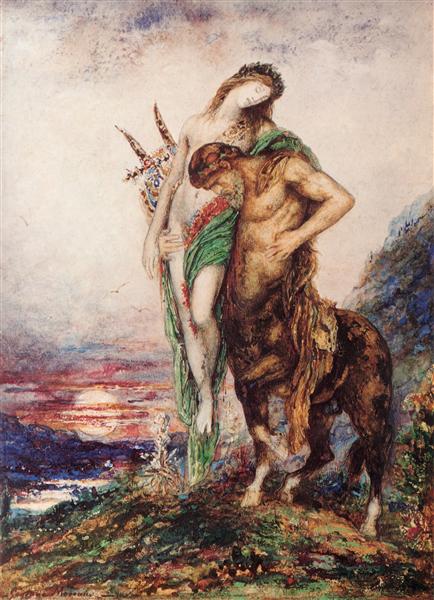Description
The work "Dead poet in charge of a centaur" (1890) by Gustave Moreau stands as a sublime and evocative testimony of the symbolism that characterized the work of the famous French painter. Moreau, known for its inclination towards the mystical and the mystical, uses this painting to explore the borders between the human and the divine, the ephemeral and the eternal.
In a detailed inspection of the composition, the first element that captures attention is the central figure of the centaur, which solemnly carries the lifeless body of a poet. The respectful and pious posture of the centaur, inclined forward, almost paying tribute to its burden, contrasts powerfully with the serenity in the poet's death. Moreau chooses to portray the mythological animal with an imposing magnificence, carefully measuring each line to enhance its power and nobility. The centaur, with his muscular and robust human torso and his equine body, symbolizes that duality between wild instinct and cultural elevation, a being anchored in both worlds.
The poet, meanwhile, lies with an expression of peace and resignation. His simple and white clothing highlights purity and artistic sacrifice, accentuating martyrdom that often accompanies poetic creation. A laurel crown, traditional laureate and celebrated symbol, adorns his head, suggesting that his death is not only a personal loss, but an event of cultural significance.
The environment that Moreau chooses to frame this scene is a hacking and dark landscape, full of dense vegetation that is insinuated more than defined. However, certain flashes of golden light emanate from behind the centaur and the poet, illuminating his figures and infusing a level of sacredness to the scene. The light effects and the use of color in this work are masterful, with the ocher tone of the centaur and the green off of the surrounding nature simultaneously evoking a sense of mystery and reverence.
Moreau, master In the creation of dream and allegorical worlds, it allows the viewer to immerse themselves in a deeper analysis of the universal issues of life and death, the nature of inspiration and the inevitable step of time. The symbiosis between the centaur and the poet cannot go unnoticed: the centaur, symbol of the primary strength and nature, and the poet, incarnation of sensitivity and the creative genius, together on a last trip that seems to challenge the inexorability of time .
While "dead poet in charge of a centaur" may not be one of Moreau's best known works, it certainly encapsulates many of the qualities that make him a unique artist within French symbolism. Works such as "Hercules and La Hidra de Lerna" and "Jupiter and Sémele" share with this painting the same emotional intensity and devotion to detail, obviously inspired by a wide reading of classical literature and a deep meditation on spirituality and mythology.
Ultimately, Moreau invites us to consider the poetic and artistic work as a sacred, transcendent trip, and in his painting, we see a perfect fusion of the profane and the divine, a visual meditation that remains alive and resonant in the spectator much After having abandoned the work. The poet's death is not only an end, but a metamorphosis, an eternal motive that continues to ride towards the immortality carried in the shoulders of the myth.
KUADROS ©, a famous paint on your wall.
Hand-made oil painting reproductions, with the quality of professional artists and the distinctive seal of KUADROS ©.
Art reproduction service with satisfaction guarantee. If you are not completely satisfied with the replica of your painting, we refund your money 100%.

